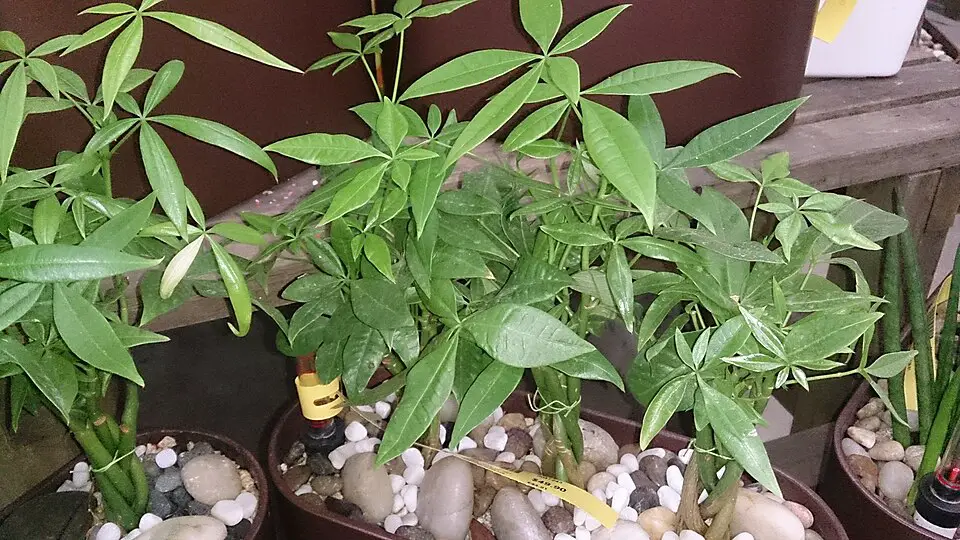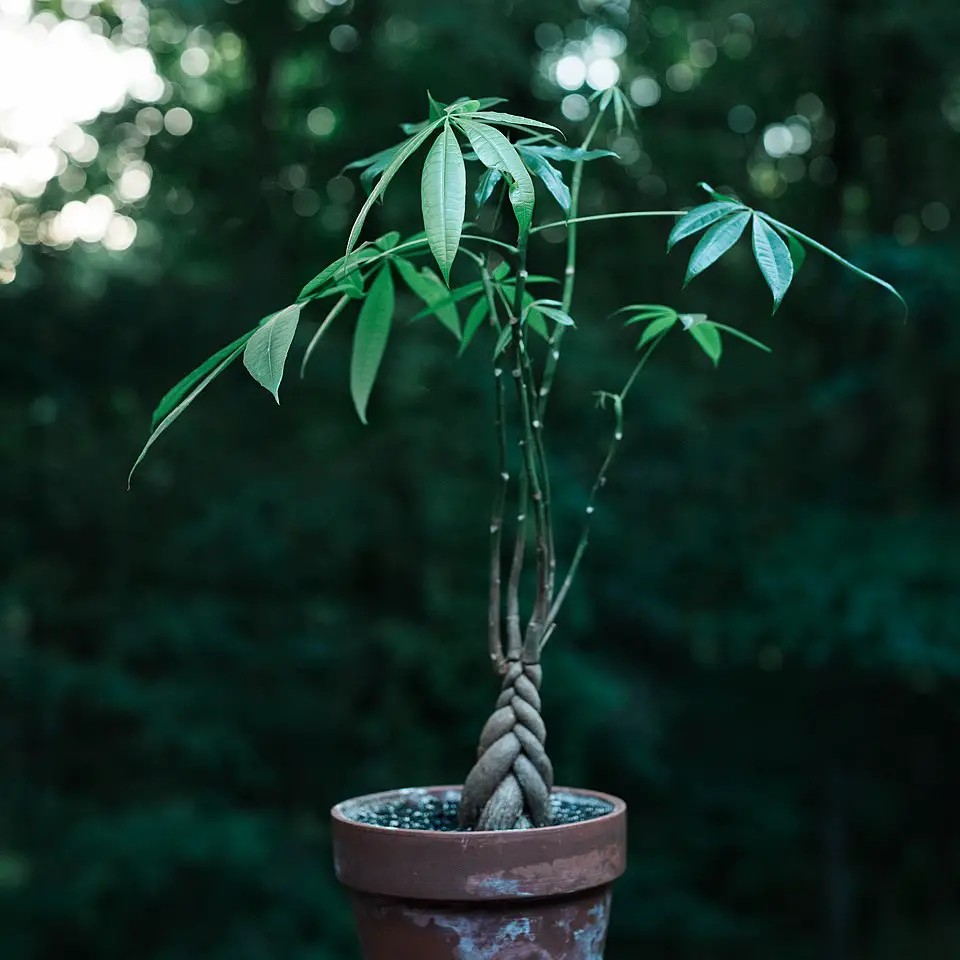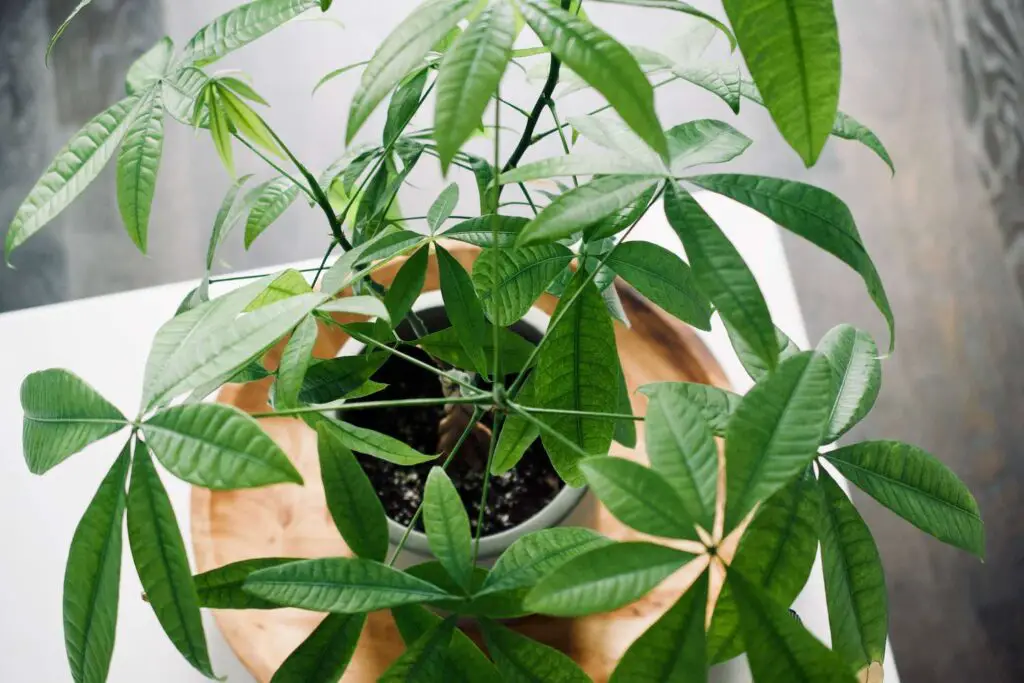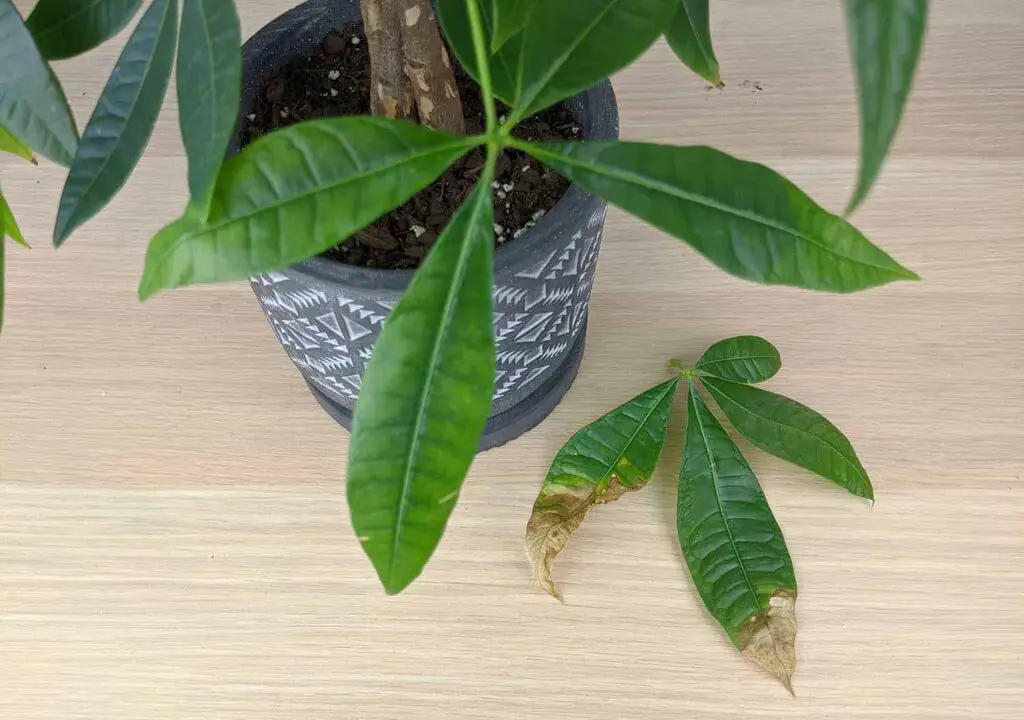The Chinese Money Tree, known scientifically as Pachira aquatica, is a popular indoor plant celebrated for its unique braided trunk and lush green leaves. Proper care includes providing the right light, water, humidity, and temperature conditions to ensure healthy growth.
The Chinese Money Tree originates from Central and South America, where it thrives in wetlands. It has gained immense popularity in homes and offices not only for its attractive appearance but also for its reputed ability to bring good luck and prosperity. Many believe that the more leaves a Money Tree has, the more wealth it can attract. This belief has contributed to its wide appeal, making it a favored choice among indoor plant enthusiasts.

Taking care of a Chinese Money Tree involves understanding its specific needs. These plants prefer bright, indirect light and can tolerate some direct sunlight. Overexposure to direct sunlight can scorch their leaves, while insufficient light may cause them to become leggy. Watering should be done when the top inch of soil feels dry. It is crucial to avoid overwatering, as this can lead to root rot.
In addition to light and water, humidity plays a significant role in the health of a Chinese Money Tree. These plants thrive in higher humidity levels, making them suitable for environments that mimic their natural habitat. Regular misting or placing a humidifier nearby can help maintain adequate moisture in the air.
Essential Care Tips for Chinese Money Trees
To keep your Chinese Money Tree thriving, here are some essential care tips:

- Light Requirements: Place your plant in bright, indirect sunlight. Rotate it occasionally for even growth.
- Watering Schedule: Water when the top inch of soil is dry. Ensure proper drainage to prevent waterlogging.
- Humidity Levels: Aim for humidity levels of 40-60%. Misting or a pebble tray can help.
- Temperature Preferences: Keep the plant in temperatures between 65°F and 80°F (18°C to 27°C).
- Fertilization: Feed with a balanced liquid fertilizer every month during the growing season (spring and summer).
Another important aspect of care is pruning. Regularly removing yellow or dead leaves will encourage new growth and maintain the plant’s appearance. Pruning also helps shape the tree as it matures. Additionally, repotting every couple of years will provide fresh soil and more room for roots to expand.
Understanding Common Issues
Even with proper care, Chinese Money Trees can experience some common issues. Here are a few problems along with their solutions:
| Issue | Symptoms | Solution |
|---|---|---|
| Overwatering | Yellowing leaves, mushy stems | Reduce watering frequency and check drainage. |
| Underwatering | Drooping leaves, dry soil | Water thoroughly and allow excess to drain. |
| Pest Infestation | Sticky residue, visible bugs | Use insecticidal soap or neem oil. |
By being aware of these potential issues and responding promptly, you can maintain a healthy and thriving Chinese Money Tree in your home or office. With the right attention and care, this beautiful plant can flourish and bring its charm into your space.

Propagation of the Chinese Money Tree
Propagation of your Chinese Money Tree can be a rewarding process, allowing you to expand your indoor garden or share plants with friends and family. There are a few effective methods for propagating this popular plant: stem cuttings and air layering. Each method has its own advantages and steps to follow.
Stem Cuttings
Stem cuttings are a straightforward method to propagate your Chinese Money Tree. Here’s how to do it:
- Select a Healthy Stem: Choose a healthy, non-flowering stem that is at least 6 inches long.
- Make the Cut: Use sterilized scissors or pruning shears to cut just below a leaf node.
- Prepare the Cutting: Remove the lower leaves from the stem, leaving a few leaves at the top.
- Rooting Hormone (Optional): Dip the cut end in rooting hormone to encourage root development.
- Plant the Cutting: Place the cutting in a pot filled with well-draining potting mix. Water lightly.
- Create a Humid Environment: Cover the pot with a plastic bag or place it in a propagator to retain humidity.
- Monitor and Water: Check regularly and keep the soil slightly moist. Remove the cover once roots form, usually in 4-6 weeks.
This method is effective and can yield multiple new plants from one parent plant. Ensure that you provide enough light for the new cuttings to thrive.
Air Layering
Air layering is another technique that can be used for propagation. This method encourages roots to develop while still attached to the parent plant. Follow these steps for successful air layering:

- Choose a Healthy Branch: Select a branch that is at least one year old and healthy.
- Make an Incision: Carefully make a small cut about one-third through the branch, just below a node.
- Apply Moist Medium: Wrap moist sphagnum moss around the cut area and secure it with plastic wrap.
- Seal the Moss: Ensure that the moss stays moist and cover it with plastic wrap to retain humidity.
- Wait for Roots: After a few weeks, check for root development. Once roots are visible through the moss, it is ready to be cut.
- Cut and Plant: Cut below the roots and pot it in well-draining soil. Water lightly.
This method is particularly useful for larger plants, as it allows you to propagate without significantly impacting the parent plant. Air layering can take longer than stem cuttings but often results in more robust plants.
Common Pests and Diseases
While Chinese Money Trees are generally resilient, they can still fall victim to pests and diseases. Identifying these issues early is crucial for effective treatment. Here are some of the most common pests and diseases you may encounter:
- Aphids: Small, sap-sucking insects that can cause leaf distortion. They are usually green or black and can be controlled with insecticidal soap.
- Spider Mites: Tiny pests that thrive in dry conditions. They create webs on leaves and can lead to leaf drop. Increase humidity and use miticides if needed.
- Mealybugs: White, cotton-like pests that cluster on stems and leaves. They can be removed with cotton swabs dipped in alcohol or treated with insecticidal soap.
- Root Rot: Caused by overwatering, this disease manifests as yellowing leaves and wilting. Ensure proper drainage and adjust watering habits to prevent it.
If you notice any signs of pests or diseases, act quickly to treat them. Regularly inspecting your plant can help catch problems early, ensuring your Chinese Money Tree remains healthy and vibrant.
Seasonal Care Considerations
Caring for your Chinese Money Tree varies slightly throughout the year. Understanding these seasonal changes can help optimize growth and health.
Spring and Summer
During the growing season, your Money Tree will require more attention. Here are some tips for spring and summer care:
- Increase Watering: As temperatures rise, increase your watering frequency while ensuring proper drainage.
- Add Fertilizer: Feed with a balanced fertilizer every month to support growth.
- Provide Bright Light: Ensure your plant receives plenty of indirect sunlight to maximize growth potential.
Fall and Winter
The cooler months require a different approach to care:
- Reduce Watering: Water less frequently as the plant enters dormancy. Allow the soil to dry out more between waterings.
- Avoid Fertilizing: Hold off on fertilizing until spring as the plant’s growth slows down.
- Monitor Temperature: Keep the plant away from cold drafts and ensure temperatures remain stable.
By adjusting your care routine according to seasonal changes, you can help your Chinese Money Tree thrive year-round.
Repotting Your Chinese Money Tree
Repotting is an essential aspect of caring for your Chinese Money Tree. This process allows the plant to access fresh soil and additional space for its roots to grow. Knowing when and how to repot will ensure your plant remains healthy and vigorous.
When to Repot
Identifying the right time to repot is crucial. Here are some signs that indicate it may be time to repot your Chinese Money Tree:
- Root Bound: If you notice roots growing out of the drainage holes or circling the surface of the soil, it’s time to repot.
- Soil Depletion: If the soil appears compacted or has broken down significantly, repotting will provide fresh nutrients.
- Growth Stagnation: If your plant has stopped growing or shows signs of distress, changing its pot and soil can rejuvenate it.
The best time to repot is during the spring or early summer when the plant is actively growing. This ensures a smoother transition and helps minimize stress on the plant.
How to Repot
Follow these steps to properly repot your Chinese Money Tree:
- Choose a New Pot: Select a pot that is one size larger than the current pot. Ensure it has drainage holes for excess water.
- Prepare Fresh Soil: Use a well-draining potting mix. A mix designed for succulents or cacti works well due to its drainage properties.
- Remove the Plant: Carefully take the Money Tree out of its current pot. Gently loosen any tightly bound roots.
- Inspect Roots: Check for any signs of rot or damage. Trim away any unhealthy roots with sterilized scissors.
- Add Soil: Place some fresh soil in the bottom of the new pot, then position the plant in the center. Fill around the sides with more soil.
- Water Thoroughly: After repotting, give the plant a good watering to help settle the soil and reduce transplant shock.
After repotting, monitor your Chinese Money Tree closely for signs of stress, such as drooping leaves or discoloration. It may take some time for the plant to adjust to its new environment.
Pruning Your Chinese Money Tree
Pruning is another important aspect of maintaining a healthy Chinese Money Tree. Regular pruning helps control its size and shape while promoting bushier growth.
When to Prune
The best time to prune your Money Tree is during the spring and summer months when it is actively growing. This timing encourages faster healing and growth after pruning.
How to Prune
Follow these steps for effective pruning:
- Gather Tools: Use clean, sharp pruning shears or scissors to make precise cuts.
- Identify Areas to Prune: Look for yellowing leaves, dead branches, or areas where growth is too dense.
- Make Clean Cuts: Cut just above a leaf node or branch junction to encourage new growth. Avoid leaving jagged edges.
- Dispose of Cuttings: Remove all cuttings from the pot area to prevent any potential pests or diseases from taking hold.
Pruning not only keeps your plant looking tidy but also improves airflow around the leaves, reducing the risk of fungal diseases.
Fertilizing Your Chinese Money Tree
Proper fertilization plays a vital role in the overall health and growth of your Chinese Money Tree. While these plants do not require heavy feeding, providing nutrients can enhance their vitality.
Types of Fertilizers
You can choose from various types of fertilizers for your Money Tree:
- Liquid Fertilizer: A balanced, water-soluble fertilizer is ideal. Look for a formula with equal parts nitrogen, phosphorus, and potassium (NPK).
- Slow-Release Granules: This type of fertilizer releases nutrients gradually over time. It reduces the need for frequent applications.
How to Fertilize
Follow these steps for effective fertilization:
- Dilute Liquid Fertilizer: If using liquid fertilizer, dilute it according to package instructions before application.
- Apply During Growing Season: Fertilize every 4-6 weeks during spring and summer when the plant is actively growing.
- Avoid Over-Fertilizing: Too much fertilizer can lead to salt buildup in the soil, harming roots. Always err on the side of caution.
The right fertilization regimen will support your Chinese Money Tree’s growth and overall health, ensuring it remains a beautiful addition to your indoor space.
Creative Ways to Display Your Chinese Money Tree
Displaying your Chinese Money Tree effectively can enhance your home decor while allowing the plant to thrive. Here are some creative ideas for showcasing your plant:
- Corner Plant Stand: Use a plant stand to elevate your Money Tree in a corner. This draws attention and allows the plant to receive ample light.
- Hanging Planters: If you have a smaller tree, consider using a hanging planter. This can create an appealing visual effect and save space.
- Terrarium Display: For smaller cuttings or young plants, a terrarium can provide a beautiful, enclosed environment while maintaining humidity.
- Grouped Arrangements: Combine your Money Tree with other indoor plants in a grouped arrangement. This creates a mini indoor garden that is visually appealing.
- Decorative Pots: Invest in decorative pots that match your home decor. A stylish pot can enhance the aesthetic appeal of your Money Tree.
Whichever method you choose, ensure that the placement allows for optimal light and air circulation, contributing to the plant’s overall health.
Common Myths About the Chinese Money Tree
The C
hinese Money Tree is surrounded by various myths and beliefs. Understanding these can help you better appreciate the plant while ensuring proper care:
- Brings Wealth and Prosperity: Many believe that having a Money Tree in your home attracts wealth and good fortune. While this may not be scientifically proven, its beauty can certainly enhance your living space.
- Requires Constant Care: Some think that the Chinese Money Tree is difficult to care for. In reality, it is a hardy plant that can thrive with minimal attention if its basic needs are met.
- Only Grows in Water: Although the plant can survive in water for short periods, it thrives best in well-draining soil. Proper soil is crucial for long-term health.
By debunking these myths, you can focus on providing the best care for your Chinese Money Tree without unnecessary worries.
Enhancing Indoor Air Quality
One o
f the benefits of having indoor plants like the Chinese Money Tree is their ability to improve indoor air quality. These plants can help filter harmful toxins from the air, making your home healthier. Here are some ways how:
- Oxygen Production: Like all plants, the Chinese Money Tree absorbs carbon dioxide and releases oxygen, contributing to fresher air.
- Toxin Reduction: Studies indicate that indoor plants can help reduce levels of certain pollutants, making your indoor environment more pleasant.
- Mood Enhancement: The presence of greenery has been shown to improve mood and reduce stress, leading to a more inviting atmosphere in your home.
Incorporating a Chinese Money Tree into your living space not only adds beauty but also promotes a healthier environment.
Final Thoughts
Caring for a Chinese Money Tree can be a rewarding experience, combining the joys of gardening with the benefits of enhancing your living space. With proper care, including adequate light, watering, and fertilization, this plant can thrive indoors for many years.
Remember to monitor for pests and diseases, repot when necessary, and prune to maintain its shape. Whether you choose to propagate or simply enjoy its presence, the Chinese Money Tree offers a unique charm that can enrich any home. Embrace these care tips and creative display ideas to ensure your Money Tree remains healthy and vibrant while adding beauty and positive energy to your surroundings.
With the right attention and understanding, your Chinese Money Tree will not only flourish but also become a cherished part of your indoor garden.
